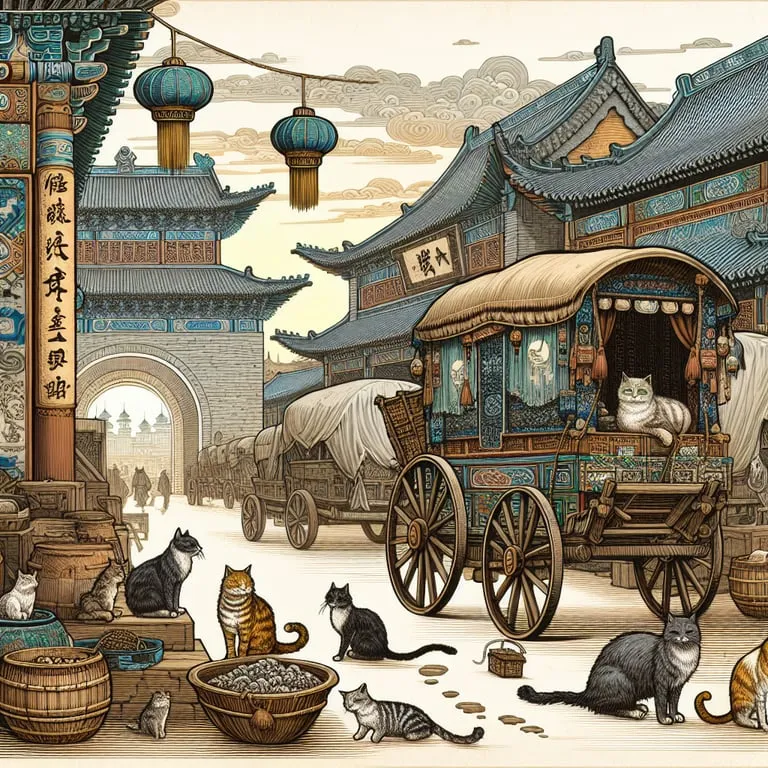Discover the captivating journey of domestic felines from the Mediterranean basin to ancient China via the Silk Road, highlighting significant genetic and cultural exchanges. This enlightening exploration reveals how domestic cats became a prized element of Chinese society, reflecting profound historical connections.

The Ancient Felines’ Journey to the East
The journey of domestic cats into ancient China is as enigmatic and graceful as the creatures themselves. These cherished companions, central to human life today, arrived on China’s shores approximately 1,400 years ago via the Silk Road. This new timeline pushes back prior assumptions about the arrival of Felis catus in East Asia, reshaping historical narratives through the lens of contemporary DNA research.
Historical Context of Feline Domestication
Domestic cats, scientifically known as Felis catus, trace their ancestry to African wildcats (Felis silvestris lybica), with initial domestication occurring approximately 10,000 years ago in the Middle East. Spreading to Europe around 3,000 years ago, they eventually journeyed to East Asia. Recent DNA analyses led by researcher Shu-Jin Luo at Peking University illuminate the role of Silk Road merchants and diplomats in transporting these exotic species to China circa AD 600, packaged as luxury gifts for the region’s elite.
Symbol of Prestige
Upon their arrival, domestic cats were welcomed as exotic pets by Chinese elites, intriguing them with unique temperaments oscillating between aloofness and affection. Cats transitioned from novel creatures to integral status symbols within Chinese society, further emphasizing the Silk Road’s role as a conduit of cultural affluence and diversity.
Archaeological and Genomic Breakthroughs
Archaeological findings confirm that the feline-human relationship in China predates domesticated cats, notably featuring the leopard cat (Prionailurus bengalensis). Featuring in rural societies for thousands of years, these felines, however, were not domesticated. The discovery of their bones, dating back 5,400 years in Shaanxi, crafts a narrative of early feline-human association without full domestication.
Comprehensive Genetic Analysis
In a pioneering study, researchers examined 22 feline remains across 14 separate archaeological sites in China, spanning nearly five millennia. This extensive analysis unearthed 14 domestic cat remains, authenticated through nuclear and mitochondrial DNA sequencing. The oldest domestic cat, unearthed in Tongwan City, Shaanxi, and radiocarbon-dated to AD 730, underscores the post-Han Dynasty timeline for domestic cats, challenging prior assumptions.
Genetic Links to the Silk Road
The study revealed a distinct genetic signature in the mitochondrial DNA of ancient Chinese domestic cats, labeled clade IV-B. Rare in Western and European cats, it intriguingly matches genetic data from a cat in Dhzankent, Kazakhstan, dating from AD 775 to 940. This match provides a critical link between Silk Road trade routes and the introduction of domestic cats to China during its peak era of AD 500-800.
Significance in Ancient Chinese Society
Upon their integration into Chinese culture, domestic cats transcended mere companionship, assuming roles both cultural and religious. Enshrined in Chinese folk religion, these animals were revered as more than property—honored as esteemed guests. Introducing cats into a household involved elaborate rituals, reflecting cultural reverence and respect for these newly arrived companions.
Cats in Chinese Culture: White Cats’ Legacy
The distinct appearance of these cats, often all-white or mackerel-tabby marked with white patches, stemmed from the genetic profiles identified in ancient remains. This attribute reflects in the current East Asian cat population, where white cats prevail more than elsewhere. This genetic legacy traces back to those initial feline settlers, establishing a distinctive regional phenotype.
Conclusion: The Silk Road’s Enduring Influence
In summary, the tale of domestic cats in ancient China weaves into the larger fabric of Silk Road commerce, embodying the rich tradition of intercultural exchanges. Reflecting on the journey and integration of these cats into Chinese society enhances the understanding of ancient trade and cultural interaction. This compelling narrative, substantiated by groundbreaking genetic research, affirms the Silk Road’s role as more than a mere economic corridor—it was a vital channel of cultural and biological enrichment.
Understanding this historical narrative enriches broader perspectives on human-animal relationships, revealing the dynamic interplay of ancient civilizations through trade and cultural diffusion. This knowledge underscores the Silk Road’s significance not just in economic terms, but also its profound impact in shaping cultural and biological heritages that persist to this day.
https://www.petmediapress.com/